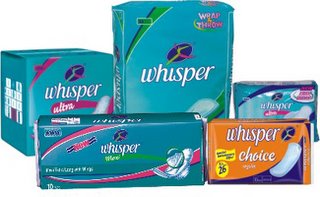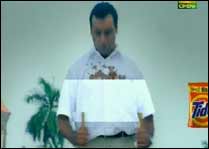To my surprise, the brand owner decided to adapt the globally successful campaign to Indian market with Milind Soman taking the place of Isaiah Mustafa. And the outcome was hopeless.
Watch the ad here : Old Spice India ad 1
Old Spice India ad 2
 Kolestant is the premium hair color brand from Wella. The brand was launched into the Indian consumer market in 2010. The brand is currently on a promotional overdrive with a series of campaigns across the media.
Kolestant is the premium hair color brand from Wella. The brand was launched into the Indian consumer market in 2010. The brand is currently on a promotional overdrive with a series of campaigns across the media. initely apply).
initely apply).  omparative ad of Rin generated huge buzz in the market. The direct comparative campaign evoked mixed reaction across the media. That single controversial ad generated crores worth of buzz about the brands in question.
omparative ad of Rin generated huge buzz in the market. The direct comparative campaign evoked mixed reaction across the media. That single controversial ad generated crores worth of buzz about the brands in question. e first time that HUL has directly compared Tide with Rin. The ad even have the tagline " Rin offers better whiteness than Tide".
e first time that HUL has directly compared Tide with Rin. The ad even have the tagline " Rin offers better whiteness than Tide". 
 uct was Oral-B 60 which had 60 tufs. In 1984 Oral-B was acquired by Gillette and in 2006 it came into P&G's fold with its acquisition of Gillette worldwide.
uct was Oral-B 60 which had 60 tufs. In 1984 Oral-B was acquired by Gillette and in 2006 it came into P&G's fold with its acquisition of Gillette worldwide. al-B revolutionized Kid's toothbrush market with its Star Wars range which had the characters in the toothbrush
al-B revolutionized Kid's toothbrush market with its Star Wars range which had the characters in the toothbrush markets this brand with all the relevant marketing mixes in place.
markets this brand with all the relevant marketing mixes in place. tented formulation that contains Niacinamide Vitamin B3 ,Vitamin E and Provitamin B5 Pathenol + sunscreen protection.
tented formulation that contains Niacinamide Vitamin B3 ,Vitamin E and Provitamin B5 Pathenol + sunscreen protection.
 uring 2005 that Head & Shoulders began its aggressive campaign to regain the lost market.The brand roped in the bubbly Preity Zinta to endorse the brand. Earlier Ajay Jadeja had endorsed the brand.During this period, the brand also extended its positioning from Anti-Dandruff to "Soft hair + dandruff removing " proposition. The brand also introduced different variants like Menthol, Aloevera, Black, Naturally Clean,smooth & silky to increase the product line depth.
uring 2005 that Head & Shoulders began its aggressive campaign to regain the lost market.The brand roped in the bubbly Preity Zinta to endorse the brand. Earlier Ajay Jadeja had endorsed the brand.During this period, the brand also extended its positioning from Anti-Dandruff to "Soft hair + dandruff removing " proposition. The brand also introduced different variants like Menthol, Aloevera, Black, Naturally Clean,smooth & silky to increase the product line depth.Brand : Whisper
Company: P&G
Agency : Leo Burnett
The female personal hygiene market in India is in a nascent stage. The market size is estimated at around rs 425 crore , some say$44mn.

The market is dominated by 3-4 players P&G, Johnson & Johnson , Dabur and Gufic. The product comes under low penetration product types. Since Indian women are not used to such products, the penetration is low but potential is high taking into account the increasing literacy and media reach. The segment commands a high brand loyalty.
Majority of the category customers still use home solutions like clothes rather than use an expensive sanitary napkin.
However J&J created this category with the launch of Stayfree during the early 80's. The heavy media investment along with the J&J endorsement opened up a new category. Stayfree was undisputed leader till the launch of Whisper.
Whisper was launched in 1989 and now account for 42% share in the sanitary napkin market in India. The brand is positioned as a premium brand.
During the early years of launch, P&G had two responsibilities 1. educate the ladies about the product 2. Promote the brand.
The marketing of Whisper is a classic case of Brand building .The initial ads were striking ones featuring mother talking about educating the daughter about using sanitary napkins
.The communication was very sensitively planned since this product is something that we Indians seldom discuss in public. The campaigns was successful in erasing the stigma attached with these kind

of products. Napkins were positioned as a modern hygiene way of protecting your lifestyle even on " those days" the ads said..
P&G has brought out lot of variants in this product trying to expand and create some waves in the market which is otherwise a dull market. Whisper is now giving stiff competition from Stayfree from J&J. Stayfree is the market leader in this category. It is credited with creating the sanitary market. But the success has made this brand complacent.
Whisper changed the game by investing lot of money in brand building. It brought the category out of closet and added a sense of premiumness into the category.
Now Stayfree is trying to corner whisper in the price. Whisper is now being forced to bring out less priced variants. Since the market is growing , at present there is lot of room to play around. Recent reports also suggest that the brands were able to penetrate rural market also.
The brands in this category face the issue of low penetration. The customers are still shy about discussing these products that creates lot of hinderance in the category growth.
Picture/ad source : Afaqs

Company:P&G
Agency; Leo Burnett
Tide is the largest selling detergent brand of P&G worldwide. Tide was launched with much fanfare in 2000.
Indian detergent industry is estimated to be around Rs5000 crore and is dominated by the marketing giant HLL. P& G although was in the Indian market for a long time was not a serious player in the detergent market. But when the Indian market opened up and the economy began to prosper, P&G could not resist entering the Indian marketin a big way. As always MNCs are too proud of their brands that they want a premium from the consumers. Here also ,Tide was launched as a premium brand and as usual got a luke warm response from the value conscious Indian consumers. P&G had to settle with a miniscule 8 % of the detergent market.
Then came 2003 and the price war started and now there is no premium brands in the detergent market in India. The price war enabled P&G to popularize the brand and increase the penetration. Although HLL and P&G did not increase their marketshare because of the price cut, the overall market size increased because the regional players lost their share to these giants.
P&G had a serious problem after the price cut because there was a chance of cannibalizing between Ariel and Tide because there was no significant differentiation between the two brands.
Now Tide has found its formula, the same global positioning as a Detergent that cleans perfectly. So using whiteness ( safedi) as a base Tide has now unleashed the campaign highlighting its whitening power against HLL's Rin which has the same positioning.
The campaigns has a desi touch and well executed. The pricing is competitive and hence HLL is forced to rope in none other than Big B to defend Rin.
Through the new strategy Tide aims to capture the safedi segment while Ariel will fight Surf in the Color segment.
A marketing fight worth watching....